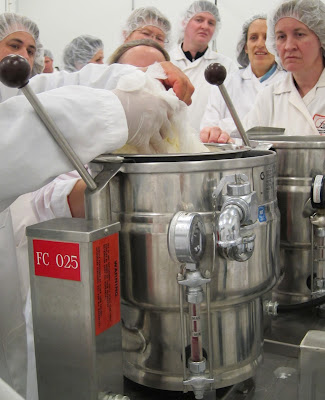Wines of Jumilla: Bodegas Silvano Garcia
 Bodegas Silvano Garcia is one of the few wineries that are still located in downtown Jumilla. I would love to visit Jumilla at harvest time and to see the tractors lumbering up the streets and entering the bodega to deliver their load of grapes.
Bodegas Silvano Garcia is one of the few wineries that are still located in downtown Jumilla. I would love to visit Jumilla at harvest time and to see the tractors lumbering up the streets and entering the bodega to deliver their load of grapes.The winery is a massive complex that previously housed the large local wine cooperative. It was originally built by a French winemaker who moved to Jumilla to continue his trade when phylloxera wiped out his vineyards in France.
You can still see some of the original fermentation tanks. They look as if they are made of painted stucco, but the rusty finish is actually the residue from the winemaking process.
The residue was a highly-valued by-product because of its concentrated flavour. People would visit the wineries and offer to clean the tanks in order to obtain the residue to make body creams, pharmaceuticals or liqueurs.
Tradition and evolution
Bodegas Silvano Garcia was founded in 1925. The current owner is the fourth generation of his family to continue in the winemaking tradition. They have 50 hectares of vineyards in the higher-altitude region to the north of Jumilla. They purchase additional grapes from local farmers.
The long history of winemaking, both within the family and within the region, certainly differentiates Old World and New World wines. But winemaking practices continue to evolve, and the challenge must be to retain what has worked well in the past while still trying out new techniques and products.
 Silvano Garcia used to produce table wines. In the last 15 years, they have shifted their attention to developing higher-quality wines. The Viñahonda label includes white, Rosado, and both young and aged red wines. The Silvano Garcia label includes a Dulce Monastrell and a Dulce Moscatel.
Silvano Garcia used to produce table wines. In the last 15 years, they have shifted their attention to developing higher-quality wines. The Viñahonda label includes white, Rosado, and both young and aged red wines. The Silvano Garcia label includes a Dulce Monastrell and a Dulce Moscatel.Due to Spain’s poor economic situation, the winery has turned its attention to foreign markets. Their young wines are popular in the United States and a number of their wines are available in Ontario, and possibly Alberta and Quebec.
Mermeladas de vino
One of the wineries’ newest products is wine jam developed from Monastrell and Moscatel wine. The sugar content is kept low so that the overall sweetness doesn’t mask the flavour of the wine.
The two wines produce two very different jams. The red Monastrell has a pronounced flavour, while the white Moscatel is much more delicate. Both are delicious with cheese. The winery’s website also suggests using them in desserts and baked goods.
Awards
Silvano Garcia’s Dulce Monastrell has won several awards in the past few years, and I am delightedly hoarding my bottle. Apparently it ages well, growing sweeter over time. I was surprised to discover how much I enjoy Spanish dulce wine as I’ve always found Canadian ice wines to be overly sweet. The Spanish have restricted the sweetness of their wines so that it enhances rather than overpowering the wine.
Silvano Garcia has won a number of awards in recent years for its white wine, Viñahonda Blanco, a dry, crisp wine made from 100% Macabeo grapes. The Viñahonda Tinto Monastrell 2010 received a special mention at the International Wine Challenge in April.
Education
Bodegas Silvano Garcia does an exceptional job of helping visitors to gain a better understanding of what is involved in producing a bottle of wine.
The aromatherapy room, a recent addition to the winery, is very impressive. Apparently, humans can detect more than 600 aromas. The winery has assembled a collection of 43 aromas to help visitors to recognize the different aromas and thus be better equipped to detect them in wine.
The aroma collection is divided into three sections. The primary aromas depend on the variety of grape, while the secondary aromas are created during fermentation. For example, you may detect a hint of strawberry in a rosado or citrus flavours in a white wine. The tertiary aromas are formed when a wine is aged, and these aromas include chocolate, vanilla and thyme.
They also display some of the aromas that you do NOT want to detect in a glass of wine, and I had an opportunity to identify the aroma of “corked” wine.
Each aroma is accompanied by a card outlining its origin and its relationship to wine.
The winery also has an informative blog.
Thanks
My sincere thanks to Juana Mari Garrido who was an informative and entertaining tour guide. And my thanks to Silvano Garcia for sending me home with samples of his winery’s products.
Jumilla, Spain: 5,000 years of growing grapes and making wine





Comments